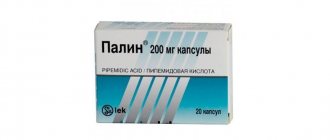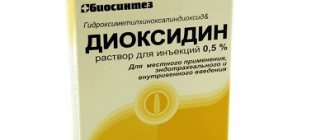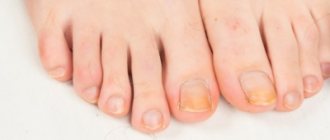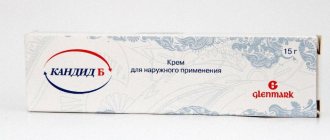Ginofort cream is an antifungal drug used in the treatment of gynecological pathologies of various etiologies. The effectiveness of the drug is based on the main substance, which inhibits the development of pathogenic microorganisms. A detailed description of the characteristics of the compound will help you become familiar with the basic properties of the drug.
Prescriptions of the drug, side effects and contraindications
The main determining factor for the use of vaginal cream is the prevention and treatment of thrush of various degrees of severity. The drug also has some contraindications:
- pregnancy;
- intolerance to its active component of an individual nature;
- breastfeeding time;
- age category of patients before reaching adulthood.
If the cream is applied, the following side effects may occur:
- severe burning and itching of the genitals;
- spasmodic pain in the lower abdomen;
- swelling of the vaginal walls.
It must be said that such negative manifestations occur in very rare cases, and if they constantly appear, it is necessary to stop using the cream.
Release form, composition and packaging
Vaginal cream
homogeneous, white to white with a gray tint, free from foreign particles and without visible separation.
| 1 g | |
| butoconazole nitrate | 20 mg |
Excipients: sorbitol, mineral oil, glyceryl monostearate, polyglyceryl-3-oleate, wax, colloidal silicon dioxide, disodium edetate, methyl parahydroxybenzoate, propyl parahydroxybenzoate, propylene glycol, water.
5 g - polypropylene applicators (1) - polystyrene pencil cases (1) - laminated bags (1) - cardboard packs.
Using the product
In accordance with the instructions, “Ginofort” is distinguished by such a feature as its one-time use. For this purpose, a five-gram applicator is used, which is inserted into the vagina. If there is no positive dynamics, an analysis for the presence of fungus in the body is required. The applicator is used once, but before using it directly it is necessary to carry out a number of certain manipulations:
- remove the applicator from the packaging and remove the protective foil from it;
- remove the special protection barrier without damaging the safety cap that contains the active component;
- insert the applicator, first removing the protective cap;
- carefully press the plunger and squeeze the cream into the vagina;
- Remove the applicator from the vagina and discard the used product.
The use of the drug during pregnancy in accordance with the instructions for Gynofort is commensurate with the expected risks for the development of the unborn baby. However, doctors generally advise using this particular drug, since reviews about it confirm its excellent effectiveness during pregnancy and breastfeeding. When carrying a child, thrush causes discomfort and discomfort; not all drugs can help, since the female hormonal background undergoes changes, and the immune system is weakened.
Candidiasis can also affect a child during passage through the birth canal. The disease must be treated, and after that prevention is carried out using effective drugs. An overdose with topical application of the cream is impossible. If the substance gets inside, symptomatic therapy is required (gastric lavage and use of adsorbents). The cream can be purchased at the pharmacy only with a doctor's prescription. It is good for three years. If its period has expired, then use is strictly prohibited. The product should be stored at a temperature of 15 to 25 degrees in a dark and dry place where access to children is limited.
This is also described in the instructions for use of Gynofort.
Gynofort: effect on the fetus
The drug Ginofort is very convenient to use during pregnancy: it does not leak from the vagina like a suppository, and it works for a long period of time. The medicine quickly relieves itching and other symptoms, while easing the condition of the pregnant woman. The full course of treatment is 7 days, but from the first days of its use the thrush will recede.
Manufacturers do not know exactly the degree of influence of the drug on the fetus.
Contraindications are based only on the results of experiments conducted on animals, since doing them on people, especially pregnant women, is completely inhumane.
The only caution when using the medicine: you should be extremely careful when inserting the medicine into the vagina, especially in the later stages, so as not to damage the placenta.
Features of interaction with other drugs
Since the cream contains mineral oil, which can damage latex and rubber products, including condoms and intravaginal diaphragms, you should avoid using such contraceptives for 72 hours (at least) after Gynofort cream (gel). The instructions for use for the product are very detailed.
Reviews of Ginoforte
Women who use Gynofort during pregnancy leave polar reviews about the drug. Some talk about the high effectiveness of the product. After administering the cream in the evening before going to bed, the next morning their unpleasant symptoms of thrush disappeared. At the same time, patients note the simplicity and comfort of using Ginofort. The cream does not flow out of the vagina after inserting the applicator. When it gets on linen, it does not leave difficult to remove stains and is easily washed off the fabric. What’s especially convenient is that you only need to use the product once.
But Ginofort was not suitable for some women. It caused the development of side effects indicated in the annotation: allergic reactions, increased itching, burning, pain in the vagina and cramps in the lower abdomen. Parabens in the cream contribute to the appearance of allergies. However, even with the development of undesirable reactions, the results of smears in these women showed that the thrush was defeated by the medication.
Find out how sinusitis is treated in pregnant women.
Why doctors prohibit hair removal during pregnancy, read here.
When Vessel Due F is prescribed to pregnant women, you will read here:.
Among the disadvantages of the drug, which are noted by reviews, it is worth noting the high cost of Ginofort. A single dose of the drug costs about 650 rubles.
Reviews from pregnant women and women who have become mothers indicate the safety of the drug for the health of the baby. The cream does not have a teratogenic effect and does not affect the course of pregnancy and childbirth. However, in no case should you self-prescribe medicine or try to treat thrush without the supervision of a gynecologist. This is dangerous, especially during pregnancy.
Special instructions for use
According to the instructions for Gynofort, if the clinical symptoms of a mycotic infection persist after treatment, the woman needs to be examined again to establish the pathological causative agent of the disease and confirm or refute the diagnosis made earlier.
If painful sensations appear in the vagina or the mucous membrane is irritated, it is necessary to stop subsequent use of the drug.
Due to the inclusion of parabens in the product, which can cause allergic reactions, you should use Ginofort cream or gel with caution.
Instructions and photos of the drug are presented in the article.
Additional instructions and analogues
After using Ginofort cream, signs of fungal infection may recur, and a subsequent re-examination is recommended to confirm or refute the diagnosis.
Ginofort vaginal cream contains parabens, which can contribute to the development of allergic reactions. The use of the drug in this case is prohibited! If pain or other discomfort occurs, do not use the cream and consult your doctor!
The average cost of Ginofort cream is 750–800 rubles. The pricing policy of the medicine is quite high, but is partially justified by the effectiveness of the medicine! The presence of contraindications or other restrictions on use suggests the use of close analogues of Gynofort, described in the list below.
- Ketoconazole. An inexpensive analogue of Ginofort, presented in the form of cream, tablets and vaginal suppositories. The drug has an antifungal effect and is effective in the treatment of gynecological pathologies of the corresponding nature. Contraindications: open wounds on the skin, individual sensitivity. Price 200–220 rubles.
- Candide. An effective substitute for the original. The drug is presented in the form of cream, powder, solution, and vaginal tablets. Area of application: treatment of fungal skin lesions, mycotic dermatitis in infants, vaginal candidiasis, dental pathologies. The medicine is not recommended during pregnancy (first trimester), breastfeeding, allergic manifestations. Price 300–320 rubles.
- Livarol. The best analogue of Ginofort, produced in the form of vaginal suppositories. The effect of the drug is based on the content of Ketocanozole, which has a pronounced antifungal effect. The medicine is intended for the treatment of thrush of varying severity, the prevention of gynecological mycotic infections, and the restoration of vaginal microflora. The use of the medication is not recommended in the presence of allergies or pregnancy (first trimester). Price 500–550 rubles.
During pregnancy and lactation
Official instructions prohibit the use of anti-thrush in pregnant women, as well as in those who are breastfeeding. But this drug is still prescribed quite often.
Many women feel the negative manifestations of pathology especially acutely during the period of waiting for a child, and due to the fear of harming the unborn baby, they live with this illness until childbirth. This decision is not entirely correct, since changes in the microflora in the vagina, discomfort and the possibility of infection of the child are a signal for the need to treat thrush.
Dosage
Intravaginally.
Treatment consists of a single application of the contents of 1 applicator (about 5 g) inserted into the vagina at any time of the day.
If symptoms of the disease persist, the mycological examination should be repeated.
Directions for using the applicator
1. Remove the foil from the packaging and remove the applicator. Do not remove the special cap placed on the applicator. Holding the applicator firmly with one hand and pulling the ring with the other, pull the piston out of the applicator as far as it will go.
2. The applicator is intended for single use. The applicator cannot be used if the cap is removed. Do not heat the applicator before use.
3. Carefully insert the applicator as deeply as possible into the vagina.
4. Slowly pressing on the piston, squeeze the cream out of the applicator.
5. Remove the empty applicator from the vagina and throw it away.
Analogs of this medication
The drug has several analogues, which are represented by topical medications (gel, suppositories, vaginal pessaries, capsules and tablets) used in the gynecological field:
- "Zalain";
- "Vagiferon";
- "Metronidazole";
- "Ginalgin";
- "Candide";
- "Gaynomax";
- "Kandibene";
- "Mikogal";
- "Trichopolus";
- "Vagisept";
- "Clotrimazole";
- "Metrogil";
- "Funginal";
- "Neo-Penotran";
- "Kandizol";
- "Orniona" and others.
Patient reviews about the drug
In the treatment of vaginal candidiasis, Gynofort cream occupies one of the most significant places. Both the reviews of specialists and the opinions of women who use it are positive in most cases, including during pregnancy. The good effectiveness of the cream and the minimization of side effects simultaneously with a single use have made this drug popular. The only negative point is the rather high cost.
We reviewed the instructions for the Ginofort cream in some detail.











